Introduction
Fruits, particularly edible fruits, have been propagated by both humans and animals in a symbiotic relationship. Fruit consumption has considerably become an unavoidable part of the complete meal as fruits are loaded with copious proportions of vitamins, minerals, protein, carbohydrate and dietary fiber (DF).1 The consumption of native seasonal fruits has a positive association, directing a practical and sustainable approach to ease malnutrition and other issues.2 Increasingly, dietary fibers are sourced from by-products of vegetables and fruits processing.3 Fruit fibers are rich in total and soluble fibers, hence exhibiting good water holding capacity, oil holding capacity and colonic fermentability.4 Fruit fibers are also known to house significant amounts of antioxidants as bioactive compounds and polyphenols.5 The short-chain fatty acids formed by the intestinal microbiota from DF play a major role in metabolism.6 Dietary fibers also found to have a potential role in alleviating Type2 diabetes, reduced risk of cardiovascular diseases and weight regulation.7
India, being a tropical country, is a producer and exporter of a wide range of fruit varieties. The fruit fibers used in this study were selected based on local availability and volume. The DF sources were outer skins of guava (Psidium guajava), rags of jackfruit (Atrocarpus heterophyllus), rinds of watermelon (Citrullus lanatus) and coconut meat (Cocos nucifera). Coconuts are the most versatile and are widely used for both their culinary and non–culinary purposes. Guavas are eaten raw and are also variedly used in culinary sauces, artisan candies, dried snacks, fruit bars, desserts, etc. The “outer skin” of guavas is rough with a bitter taste to sometimes soft. The outer skin may be of any thickness varying between the varieties. Jackfruit is a multiple fruit with a sharp flavor and taste. In our study, “rags” or the inedible fibrous part of the fruit was used. These rags may be sweet or bitter depending on the variety. Watermelons are large edible fruits with a hard rind and no internal division. The “rinds” are usually green with dark green stripes housing the red, sweet juicy pulp. Watermelon rinds are also edible but are not commonly consumed because of their strong and unappealing flavor and taste because of the presence of the amino acid citrulline.8 The purpose of our research was to find out the proximate composition besides the functional characteristics of processed fruit fibers.
Materials and Methods
Sample preparation- Processing of fruits
Our study used fruits that were bought from the local market in Vellore, India. The fruits underwent rinsing with running water to eliminate impurities on the outer surface. The coconut husks and shells were removed, and the edible part was separated. After the coconut meat was recovered, it was cut into small pieces, dried, and then finely ground using an electric mill. The rinds were removed from the fruit pulps with the help of a sharp knife. Dried watermelon rinds, guava skin, jackfruit rags and coconut meat were finely ground in an electric mill after being dried separately in a hot air oven at 60℃ and sieved using a 4mm laboratory sieve. The solvent extricates were resolved using a Soxhlet apparatus with sequential treatment with ethanol and petroleum ether. Soxhlet extraction is still considered being an effective extraction procedure as it facilitates a maximum recovery of bioactive substances such as phenolic acids, flavonoids, carotenoids, anthocyanin and other substances.9 The raw samples were processed with ethanol for 9 hours to remove phenolics and other reactive substances. The processed samples were oven dried at 60℃ for 3 hours. Upon drying, the samples were treated again with petroleum ether for 6 hours to remove fatty acids and other saturated fats. After extraction, the samples were recovered from the Soxhlet and oven dried at 60℃, cooled at room temperature and stored at 4℃, labeled in screw-capped bottles until further use.
Proximate analysis
Proximate analysis was performed on the indicated fruit fiber samples. Moisture, ash, protein, fat and fiber was deduced in concordance with AOAC (2005).10 Moisture was determined by drying in the oven at 100℃ for 24 hours until a steady weight was obtained. The ash content was estimated in a muffle furnace at 600℃ for 3 hours. Nitrogen content was evaluated by Kjeldahl method. Carbohydrate was calculated by difference.
Functional characterization
Hydration properties
The hydration properties of fruit fibers were determined according to Robertson et al.,11 Water holding capacity (WHC) was estimated through treating fibers with deionized water and sodium azide ( NaN3), hydrated for 18 hours. The supernatant was removed after centrifugation and the substrate was recovered, filtered and dried to constant weight at 110℃. Water holding capacity was expressed as weight of dry fiber after water absorption.

Water retention capacity (WRC) was determined by treating the fibers with deionized water and sodium azide ( NaN3), shaken well and allowed to settle down. The supernatant was removed, filtered and centrifuged at 3000g/20min, left undisturbed at room temperature for 3 hours, dried at 105℃ and the dry weight was estimated.

Absorption Capacity (ABC) was determined by mixing the sample with deionized water and 0.02% sodium azide ( NaN3), unshaken for 18 hours and bed volume recorded. Absorption capacity was measured as the final volume gained by fiber after 18 hours.

Oil Holding Capacity (OHC) was estimated through mixing fiber sample with vegetable oil and allowed to stand for 1 hour, centrifuged at 1600g/25min. The unabsorbed oil was decanted and the absorbed oil was determined by difference and expressed as volume of oil per gram of sample.

Size distribution and Zeta potential
The size distribution of fruit fibers was analyzed using a Malvern Nano Zetasizer ZS 90, (Malvern Panalytical, UK) measuring nanoparticle size using dynamic light scattering technique.
Texture analysis
The texture analysis of processed fruit fibers was carried out using a TA.HD plus C Texture analyzer [capacity750kg.f (7.5kN) speed range 0.01-20mm/s, Stable Micro Systems, UK].
SEM analysis
The scanning electronic microscopy (SEM) analysis was performed to visualize the texture and morphology of fruit fibers. SEM images of fruit fibers were determined using a Zeiss – SEM instrument (Germany).
Results and Discussion
Proximate analysis was performed with different fruit fiber samples according to the standard AOAC procedure and the results are given in Table 1. From the results obtained, it was observed that moisture, ash and protein content is significantly higher in watermelon fibers than in other fibers. The fiber composition was approximately the same as all fibers. Coconut and jackfruit fibers showed an increased level of fat content than the other two fibers. Carbohydrate by difference and energy value were also observed to be higher in coconut and jackfruit fibers comparatively. Our results with fruit fibers were like the observations by Dias et al with different fruit peels.12 The differences may be because of the variety of cultivars, geographical factors and varied composition of water in fruits. Ash content also differed in all the fruits, which indicate minerals that characterize the nutritive value, which is highly influenced by environmental factors.13 The results expressed below are the mean ± standard deviation of triplicates.
Table 1: Proximate Analysis of Fibers
|
S.No. |
Parameters |
Coconut Fiber (CF) |
Guava Fiber (GF) |
Jackfruit Fiber (JF) |
Watermelon Fiber (WF) |
|
1. |
Moisture content (%) |
2.88 ± 0.10 |
9.03 ± 0.31 |
9.18 ± 0.57 |
11.97 ± 0.12 |
|
2. |
Ash content (%) |
0.54 ± 0.03 |
0.94 ± 0.04 |
4.85 ± 0.35 |
7.37 ± 0.33 |
|
3. |
Fiber (%) |
25.82 ± 1.11 |
25.07 ± 0.55 |
21.4 ± 0.28 |
24.55 ± 0.60 |
|
4. |
Fat content (%) |
3.83 ± 1.52 |
1.86 ± 0.31 |
3.35 ± 1.20 |
1.29 ± 0.79 |
|
5. |
Protein content (%) |
6.64 ± 0.67 |
4.97 ± 0.55 |
8.39 ± 0.52 |
13.72 ± 0.75 |
|
6. |
Carbohydrate by difference (%) |
21.37 ± 0.41 |
42.80 ± 0.60 |
49.12 ± 0.53 |
31.20 ± 1.01 |
|
7. |
Energy value/100g (Kcal/kg) |
510.41 ± 0.74 |
271.8 ± 0.76 |
328.06 ± 0.68 |
241.09 ± 1.40 |
The hydration properties of coconut fibers were observed to be significantly higher than that of the other fibers, followed by watermelon fibers. This may be because of the loose and sizable interstitial framework, which is the fundamental characteristic of water and oil holding capability and other absorption properties. Our results were like that of Feng et al.,14 with citrus fibers which exhibited excellent physicochemical properties and it has been reported that the microstructure of fibers is correlated with the physicochemical properties. Regarding literature reports, the hydration properties of fibers were noticed to be weak with a reduction in particle size and the oil holding capacity of fibers was observed to improve with diminished particle sizes upon processing.15 The results of hydration properties of fibers such as water holding capacity, water retention capacity, absorption capacity and oil holding capacity are given in Table 2. The hydration properties determine the fate of dietary fibers and the rate of digestion to a certain extent and account to some of the physiological effects like adding bulk to the stool, lowering the risk of diverticular diseases by easing constipation and preventing intestinal blockages.16 The results are expressed as mean ± standard deviation of triplicates.
Table 2: Hydration Properties of Fibers
|
S.No. |
Fiber |
Water Holding Capacity(%) |
Water Retention Capacity(%) |
Absorption Capacity (%) |
Oil Holding Capacity (%) |
|
1. |
Coconut Fiber |
3.39 ± 0.04 |
2.76 ± 0.042 |
6.0 ± 0.28 |
3.17 ± 0.05 |
|
2. |
Guava Fiber |
2.23 ± 0.15 |
1.93 ± 0.049 |
2.5 ± 0.29 |
2.60 ± 0.03 |
|
3. |
Jackfruit Fiber |
2.68 ± 0.06 |
1.59 ± 0.042 |
2.8 ± 0.35 |
2.44 ± 0.04 |
|
4. |
Watermelon Fiber |
2.9 ± 0.04 |
2.28 ± 0.035 |
3.6 ± 0.21 |
2.08 ± 0.03 |
The zeta analyzer is used to measure particle size, zeta potential, molecular charges and electrophoretic mobility of nano particles. Molecular size is one of the salient feature that plays a significant role in managing certain systemic functions of the gastrointestinal tract, such as passage and fermentation time, stool bulking and excretion, etc. The diversity in molecular size is a resultant from the cell wall pattern and framework and processing. The size distribution by intensity was determined based on the peak intercepts. Water was used as the dispersant and the temperature and viscosity were maintained throughout. The charges in fibers were determined by the zeta-potential of corresponding fibers and the net charge on the fibers was observed to be negative. This charge exhibited by the fiber particles plays a vital role in either attaching or repelling substances inside the gut. For instance, the common gut microbiota Lactobacilli, inorganic salts and other organic substances present in the gut adhere to the dietary fiber remnants upon ingestion and fermentation, which is solely based on the charges of the fiber particle.17 The size distribution and zeta potential of fibers determined is given in Table 3 and the peak intercepts of size distribution by intensity are shown in Figure 1 (A-D).
Table 3: Size Distributions by Intensity and Zeta-Potential
|
Fiber |
Dispersant |
Temp (℃) |
Count rate (kcps) |
Z -Avg (d.nm) |
PdI |
Peak intercept |
Particle size (d.nm) |
% Intensity |
Std Dev (d.nm) |
Zeta Potential (mV) |
|
Coconut Fiber |
Water |
25 |
17.8 |
519.4 |
0.726 |
0.977 |
204.4 |
100 |
23.09 |
-18.4 |
|
Guava Fiber |
Water |
25 |
6.6 |
293.3 |
0.507 |
0.842 |
112.2 |
100 |
11.55 |
-14.9 |
|
Jackfruit Fiber |
Water |
25 |
2.3 |
440.3 |
0.660 |
0.425 |
214.1 |
76.4 |
51.86 |
-15.3 |
|
Watermelon Fiber |
Water |
25 |
7.4 |
266.9 |
0.469 |
0.692 |
169.8 |
100 |
30.73 |
-16.8 |
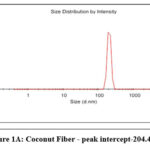 |
Figure 1A: Coconut Fiber – peak intercept-204.4 |
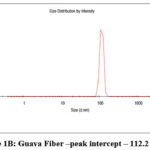 |
Figure 1B: Guava Fiber –peak intercept – 112.2 |
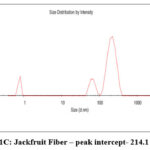 |
Figure 1C: Jackfruit Fiber – peak intercept- 214.1 |
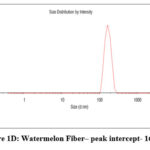 |
Figure 1D: Watermelon Fiber– peak intercept- 169.8 |
Using a Texture Analyzer, the hardness, adhesiveness, gumminess, cohesiveness, springiness, chewiness, and resilience were measured to determine textural properties. Table 4 presents the results of the textural analysis conducted on fruit fibers. Coconut fibers were discovered to have a higher hardness, gumminess, adhesiveness, and chewiness than other fibers. Perhaps the reason for their hardness is due to coconut fibers resistance to deformation and chemical changes. Coconut fibers’ inherent property causes increased gumminess, adhesiveness, and cohesiveness. The springiness of coconut fibers was also found to be higher than other fibers, and this is because of their lower water binding and water retention capacities and they are less tensile. The resilience of watermelon fibers was observed to be greater than the other fibers. This may be because of the high water binding capacity of watermelon fibers that makes them easily resilient upon water absorption. The guava fibers and jackfruit fibers were found to exhibit intermediary properties when compared to coconut and watermelon fibers.
Table 4: Texture Analysis of Fibers
|
S.No. |
Parameters |
Coconut Fiber (CF) |
Guava Fiber (GF) |
Jackfruit Fiber (JF) |
Watermelon Fiber (WF) |
|
1. |
Hardness |
2702.57 |
1267.96 |
582.33 |
801.60 |
|
2. |
Adhesiveness (g.sec) |
-213.07 |
-15.92 |
-7.29 |
-20.74 |
|
3. |
Springiness |
0.85 |
0.76 |
0.79 |
0.67 |
|
4. |
Cohesiveness |
0.45 |
0.36 |
0.37 |
0.35 |
|
5. |
Gumminess |
1228.63 |
452.18 |
213.86 |
246.43 |
|
6. |
Chewiness |
1065.34 |
346.58 |
172.68 |
165.10 |
|
7. |
Resilience |
0.04 |
0.09 |
0.07 |
0.10 |
For SEM analysis, the surface area of fruit fibers was measured at a resolution ranging from 10µm-20µm. The pore size and permeability affects fiber fermentation, whereas the asymmetrical arrangement of the exterior layer contributes to enhance the physiological attributes. Regarding SEM images, the porosity and surface area of dietary fibers convenient for bacteria or other molecular transcripts and enzymes highly depend on the configuration and framework of fiber and that is directly correlated to the species and its processing history and the extent of fermentation.18 The SEM images of fibers obtained are given Figure 2 (A-D).
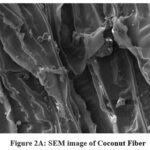 |
Figure 2A: SEM image of Coconut Fiber |
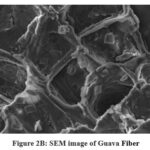 |
Figure 2B: SEM image of Guava Fiber |
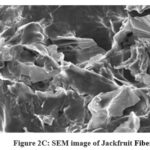 |
Figure 2C: SEM image of Jackfruit Fiber |
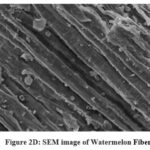 |
Figure 2D: SEM image of Watermelon Fiber |
Conclusion
The results and findings of this research work bring out the physiological and functional properties of fruit fibers in relation to their suitability as prebiotic. Dietary fiber is a composite assortment of chemical structures and its constitution in diverse sources has never been uniform or constant. This miscellaneous diversity illustrates the intricacy of innate features associated to dietary fibers. The physiological characteristics of dietary fibers are contingent on its physicochemical properties. Besides these attributes, the plant cellular framework influences the storage stability and sensory characteristics of dietary fibers. In case of any technological processing, the physiological characteristics of dietary fibers may be surpassed and consequently, the physiological and functional effects may be significantly altered.
Acknowledgement
The authors thank the VIT management for funding and supporting this research.
The authors acknowledge and thank Dr. Z. John Kennedy from Post-Harvest Technology Centre (PHTC) Tamil Nadu Agricultural University (TNAU), Coimbatore for some research facilities.
Conflict of Interest
The authors have no conflict of interest pertaining to this study.
Funding Sources
The author(s) received no financial support for the research, authorship, and/or publication of this article.
References
- Slavin JL, Lloyd B. Health benefits of fruits and vegetables. Adv Nutr. 2012;3(4):506-516. doi:10.3945/an.112.002154.
CrossRef - Sandeep Sachdeva, Tilak R Sachdev and RS. Increasing fruit and vegetable consumption: challenges and opportunities. Indian J Community Med. 2013;38(4):192-197. doi:doi: 10.4103/0970-0218.120146
CrossRef - Macagnan FT, Santos LR Dos, Roberto BS, De Moura FA, Bizzani M, Da Silva LP. Biological properties of apple pomace, orange bagasse and passion fruit peel as alternative sources of dietary fibre. Bioact Carbohydrates Diet Fibre. 2015;6(1):1-6. doi:10.1016/J.BCDF.2015.04.001
CrossRef - Williams B, Grant L, Gidley M, Mikkelsen D. Gut Fermentation of Dietary Fibres: Physico-Chemistry of Plant Cell Walls and Implications for Health. Int J Mol Sci. 2017;18(10):2203. doi:10.3390/ijms18102203
CrossRef - Wang L, Xu H, Yuan F, Pan Q, Fan R, Gao Y. Physicochemical characterization of five types of citrus dietary fibers. Biocatal Agric Biotechnol. 2015;4(2):250-258. doi:10.1016/j.bcab.2015.02.003
CrossRef - Teixeira C, Nyman M, Andersson R, Alminger M. Application of a dynamic gastrointestinal in vitro model combined with a rat model to predict the digestive fate of barley dietary fibre and evaluate potential impact on hindgut fermentation. Bioact Carbohydrates Diet Fibre. 2017;9:7-13. doi:10.1016/j.bcdf.2016.12.001
CrossRef - Slavin J. Fiber and prebiotics: Mechanisms and health benefits. Nutrients. 2013;5(4):1417-1435. doi:10.3390/nu5041417
CrossRef - Rimando AM, Perkins-Veazie PM. Determination of citrulline in watermelon rind. J Chromatogr A. 2005;1078(1-2):196-200. doi:10.1016/J.CHROMA.2005.05.009
CrossRef - Anabela Borges, Helena José, Vera Homem and MS. Comparison of Techniques and Solvents on the Antimicrobial and Antioxidant Potential of Extracts from Acacia dealbata and Olea europaea. Antibiot. 2020;9(2):48. doi:10.3390/antibiotics9020048
CrossRef - AOAC. Determination of Moisture, Ash, Protein and Fat. Association of Official Analytical Chemists (AOAC), Washington DC, USA, 19th edition. Published online 2005. doi:https://doi.org/10.1002/0471740039.vec0284
CrossRef - Robertson, J.A., Monredon, F.D., Dysseler, P., Guillon, F, Amado, R. and Thibault J. Hydration properties of dietary fibre and resistant starch: a European collaborative study. Leb Wiss Technol. 2000;(33):72-79. doi:10.1006/fstl.1999.0595
CrossRef - Dias,P.G.I, Sajiwanie,J.W.A, Rathnayaka RMUS. Chemical Composition, Physicochemical and Technological Properties of Selected Fruit Peels as a Potential Food Source. Int J Fruit Sci. 2020;20(2):S240-S251. doi:https://doi.org/10.1080/15538362.2020.1717402
CrossRef - Andrzej Cezary Żołnowski, Mirosław Wyszkowski ERMS. Mineral Materials as a Neutralizing Agent Used on Soil Contaminated with Copper. Mater. 2021;14(22):6830. doi:10.3390/ma14226830
CrossRef - Feng X, Yu B, Regenstein JM, Wang L. Effect of particle size on composition, physicochemical, functional, and structural properties of insoluble dietary fiber concentrate from citrus peel. Food Sci Technol Int. 2023;29(3):195-203. doi:10.1177/10820132211063973
CrossRef - Raghavendra SN, Ramachandra Swamy SR, Rastogi NK, Raghavarao KSMS, Kumar S, Tharanathan RN. Grinding characteristics and hydration properties of coconut residue: A source of dietary fiber. J Food Eng. 2006;72(3):281-286. doi:10.1016/j.jfoodeng.2004.12.008
CrossRef - Haoshuang Chen , Shudong He , Hanju Sun , Qiuyang Li , Kuan Gao , Xinya Miao , Jie Xiang , Xiongjie Wu LG and YZ. A Comparative Study on Extraction and Physicochemical Properties of Soluble Dietary Fiber from Glutinous Rice Bran Using Different Methods. Separations. 2023;10(2):90. doi:https://doi.org/10.3390/separations10020090
CrossRef - Thongngam, M., and McClements DJ. Isothermal titration calorimetry study of the interactions between chitosan and a bile salt (sodium taurocholate). Food Hydrocoll. 2005;19(5):813-819. doi:https://doi.org/10.1016/j.foodhyd.2004.11.001
CrossRef - Guillon F., Auffret A., Robertson J.A. TJ. and BJL. Relationships between physical characteristics of sugar-beet fiber and its fermentability by human fecal flora. Carbohydr Polym. 1998;37(2):185-197. doi:https://doi.org/10.1016/S0144-8617(98)00053-8
CrossRef

This work is licensed under a Creative Commons Attribution 4.0 International License.






